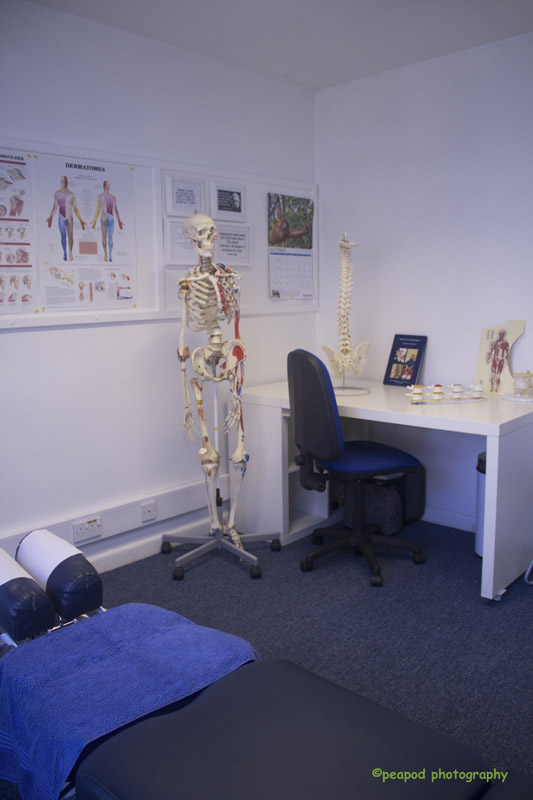About Your Visit
Your First Treatment
You will be asked to wear loose clothing is the most appropriate in order to allow adequate physical examination. Ladies will feel more comfortable in trousers but it is not essential. Men will be more comfortable in loose trousers and jeans rather than tight, but again not essential, only for your comfort.
The consultation is three quarters of an hour and will include a medical history, physical examination and a detailed report of findings using models where necessary.
We will tell you the diagnosis of your problem with a comprehensive explanation of how the condition occurred, what activities aggravate the condition and most importantly the type and duration of treatment needed to return you and your body back to normal.
Once everything is explained and the patient consents a treatment is carried out.

Who Can Benefit? Everyone!
Young or Old. From neonate to nineties. Whatever your problem Chiropractors deal with all joints in the body.
They are primary care providers that have the ability to diagnose all conditions, create a treatment plan and execute it.
They are capable of taking and reading x-rays and will refer to an appropriate consultant if necessary.
Whatever your problem I can help identify any issues that maybe aggravating your condition and teach you to adapt your lifestyle.
This means you don’t have to give up that favourite sport or rewarding job, but can learn to minimize the impact.
Treatment in Detail
With the use of my hands a gentle manipulation of the joints is carried out at the designated level to ensure realignment of the joint.
This will increase range of motion, reduce pain levels and promote correct functioning of the area.
Treatment – unfortunately is not a one off fix for many reasons. A condition that has been left untreated for a number of months takes longer (weeks) to correct than a condition that has occurred in the last few days.
The treatment is carried out in three phases:
To reduce pain
High intensity of treatments in the first weeks to reduce pain and mobilise joints.
Rehabilitation
Lengthen time between treatments. As the body responds introduce self help instructions ranging from simple stretches to exercises. General life styles are analysed and alterations to occupations are assessed if needed. Adaptations to gym routines and encouragement to start exercise. This will ensure compliance and enables the patient to start listening to their bodies again making them much more aware of when problems are occurring.


Maintenance
Encouragement to return at least four times a year to give the body a ‘service’, double check those stretches or to cope with any changes to your lifestyle e.g. moving home caring for a sick relative or taking up a new sport. These all bring their own stresses and strains.
Remember Painkillers do not treat the problem. How often have you thought “Oh it will just go on its own” only to find the condition worsens?
FAQs
How are you different from Osteopaths and Physiotherapists?
Predominately Osteopaths use slightly different manipulation techniques. Generally long lever slower amplitude manipulation compared to short lever faster amplitude manipulations. Chiropractors have been trained to operate radiology equipment, if the clinic possesses one. There is some evidence that Osteopaths concentrate more on your circulatory system, whereas chiropractors concentrate on the nervous system. However both systems are as important as the other and both practitioners are able to recognize problems with either system. Chiropractors and Osteopaths concentrate similarly on occupational and lifestyle advice.
Physiotherapists are specialists in rehabilitation e.g. Stroke victims, amputees, broken or repaired limbs. They predominately use heat, ultrasound and exercise to help individuals. Private physiotherapists are qualified to diagnose conditions and may often use manipulation techniques. NHS physiotherapists receive the diagnosis from the GP.
Will it hurt?
A properly executed manipulation is not painful. However patients should remember that joints are being moved and the body realigned. This may mean there is some residual soreness, but this is considered negligible when pain levels are reduced and mobility restored – even on the first visit!
How many treatments will I need?
This is directly related to the length of time you have had the condition. Your general medical history and your overall levels of fitness impact on recovery. The stresses and strains you put upon your body daily, either through work or hobbies are added variables that affect improvement. Each of us are slightly anatomically different or may have hereditary or genetic disorders to consider. In summary it is not a quick fix.
How are you different from other Chiropractors?
I firmly believe in tailoring a treatment plan for the individual taking into account your condition.
There are no pre-payment plans, or signing up for a set amount of treatments. I ensure treatment is reduced as the pain subsides gently easing you back to normality.
I empower you to take control of your lifestyle. Showing you minor or major changes you can make, that have a minimal disruption to your lifestyle. E.g.I’m a realistic person – I’m not going to ask you to go to the gym three times a week, but if that’s what you want to do then we will write a training program that takes into account your injuries specific to you.
I firmly believe in home rehabilitation, stretches or exercises that can be incorporated into activities of daily living, so you can continue to improve outside of treatments.
